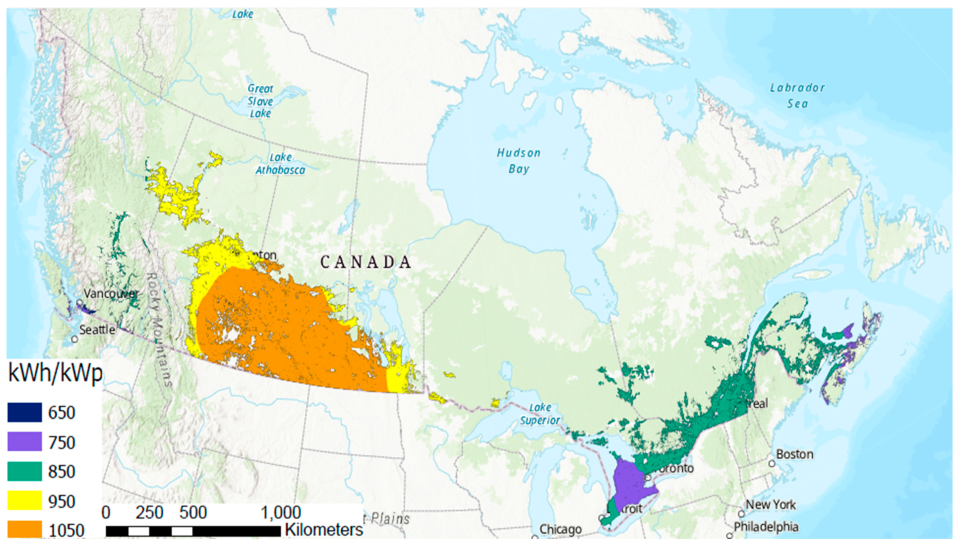How just 1% of farmland could meet one third of Canada’s energy needs
Canada’s 62.2 million hectares of farmland is regularly eyed for solar power plants. In some cases, like with sheep or bees, agriculture and solar panels can run side-by-side as great neighbours. But for plants, things are trickier, as some crops need sunlight to grow their best.
But recent research into “agrivoltaics” — putting solar panels on a parcel of land that grows food — suggests that this isn’t always a dealbreaker. In fact, according to the paper, setting up certain types of solar panels alongside commercial plant crops can play a huge role in generating renewable energy in Canada.
To study this, Joshua Pearce, a researcher at Western University’s department of electrical and computer engineering, and his team began looking into previous studies about how plant crops fared alongside PVs. Mostly, these came from other countries, such as Germany as parts of its climate are similar to Canada’s, he explained.
READ MORE: How Kanaka Bar is creating a path forward following climate catastrophe
Pearce noted that, while solar panels can cast shade over plants, that didn’t always hinder their growth a lot. A study from 2021 suggests that chard and kale cand fare quite well with power-producing neighbours taking up some of their sun.
With this data in hand, the researchers looked at government geographic information system (GIS) data, and modelled where ideal sunlight for PV occurs on Canadian farmland, along with which parts of agriculture land is used for crops that didn’t mind a bit of shade.
“So, the way we did this study was: everyone uses their current crops. They would follow the same farming practices they use now, and we would just build the solar farms around them. And that's to cover all of our electrical needs,” Pearce told The Weather Network.

A map of solar power potential on farmland across Canada. (Joshua Pearce/ Western University)
In particular, the study looked at two forms of PV: vertical, where the face of the panels are aligned horizontally; and single-axis tracking systems, where a motor tilts the face of the panels to better catch the sun. In each of the parcels of land modelled, the two types of PVs were set up with enough distance between them for farming equipment to move through, Pearce said.
The paper found that agrivoltaics have a huge potential in Canada. In the case of vertical PV, more than one quarter of Canada’s energy needs can be met by using just one per cent of Canada’s farmland.
Single-axis tracking can reach one third of Canada’s needs with this amount of land as well. This rate varied by province. For instance, Ontario would need only half of a percent of its farmland to be converted to single-axis tracker PV operations to get to net-zero emissions, according to the paper. In part, this is because the province’s energy grid was 92 per cent non-emitting as of 2019.
Meanwhile, Alberta’s energy grid is carbon intensive, with only 10 per cent of its generation coming from renewables in 2019. But putting single-axis PVs on one per cent of its agricultural land could cut its greenhouse gas emissions from burning fossil fuels for electricity, according to the report. On the other hand, Atlantic Canada, which relies on fossil fuels and has a relatively small surface area, would need to dedicate 2.5 per cent of its land to single-axis tracker PVs to decarbonize its grid.
Watch below: How this PEI resident lives off-the-grid in a modern home
He noted that excess energy not used by the Canadian grid could also be sold to the United States, or stored in batteries.
Reaching these high-tier outcomes would cost a lot of money. But, the paper notes that this cost could be offset by carbon credits or government incentives. Hypothetically, solar power producers could also team up with farmers, leasing their land, to create these kinds of operations, Pearce said. “And what agrivoltaics gets to is another profit center, where if you're producing more food on the same amount of land that you were before you installed solar, the farmer is going to make more money.”
Thumbnail image: Koami Hayibo, a Western Engineering PhD student, is developing floating photovoltaic racking for solar panels to be installed on water surfaces (e.g. ponds and lakes) which can be used for aquavoltaics in addition to reducing evaporation losses to conserve water. (Supplied/ Christopher Kindratsky)


